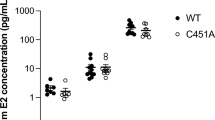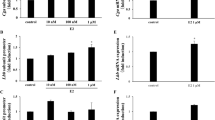Abstract
Although estradiol (E2) plays a critical role in the promotion of pituitary development and in the regulation of various pituitary hormones, its effects on the thyroid-stimulating hormone (TSH) remain unaddressed. The actions of E2 are mediated by two classical nuclear estrogen receptors α (ERα) and β (ERβ) and the G protein-coupled estrogen receptor (GPER). However, the types of estrogen receptor involvement in the regulation of thyrotropes are still limited. In this study, we demonstrate that ERα, but not ERβ and GPER, is localized to thyrotropes in the pituitary of female mouse. In agreement with the presence of ERα in thyrotropes, E2 was shown to stimulate TSH release in vitro from primary culture of female mouse pituitary cells. PPT, a ERα-selective agonist, but not DPN (a ERβ-selective agonist) and G-1 (a GPER-selective agonist), was shown to stimulate TSH release in mouse pituitary cells. This effect could be prevented by the specific ER antagonist fulvestrant and the selective ERα antagonist MPP. The findings of this study suggest that E2 may bind to ERα to trigger TSH release and provide novel information on the differential regulation of multiple estrogen receptors in the pituitary.



Similar content being viewed by others
Data Availability
The datasets generated or analyzed during the current study are presented in the manuscript and are available from the corresponding author upon reasonable request.
Code Availability
Not applicable.
References
Katzenellenbogen, B. S., Montano, M. M., Ediger, T. R., Sun, J., Ekena, K., Lazennec, G. … Katzenellenbogen, J. A. (2000). Estrogen receptors: selective ligands, partners, and distinctive pharmacology. Recent Progress in Hormone Research, 55, 163–195
Nilsson, S., Mäkelä, S., Treuter, E., Tujague, M., Thomsen, J., Andersson, G. … Gustafsson, J. A. (2001). Mechanisms of estrogen action. Physiological Reviews, 81(4), 1535–1565
De Francesco, E. M., Sotgia, F., Clarke, R. B., Lisanti, M. P., & Maggiolini, M. (2017). G protein-coupled receptors at the crossroad between physiologic and pathologic angiogenesis: old paradigms and emerging concepts. International Journal of Molecular Sciences, 18(12), 2713
Zimmerman, M. A., Budish, R. A., Kashyap, S., & Lindsey, S. H. (2016). GPER-novel membrane oestrogen receptor. Clinical Science (London, England: 1979), 130(12), 1005–1016
Levin, E. R., & Hammes, S. R. (2016). Nuclear receptors outside the nucleus: extranuclear signalling by steroid receptors. Nature Reviews Molecular Cell Biology, 17(12), 783–797
Christian, H. C., & Morris, J. F. (2002). Rapid actions of 17beta-oestradiol on a subset of lactotrophs in the rat pituitary. The Journal of physiology, 539(Pt 2), 557–566
Beardwell, C., & Robertson, G. L. (Eds.). (1981). The Pituitary, Butterworths, London and Boston, pp. 337
Seilicovich, A. (2010). Cell life and death in the anterior pituitary gland: role of oestrogens. Journal of Neuroendocrinology, 22(7), 758–764
González, M., Reyes, R., Damas, C., Alonso, R., & Bello, A. R. (2008). Oestrogen receptor alpha and beta in female rat pituitary cells: an immunochemical study. General and Comparative Endocrinology, 155(3), 857–868
Mitchner, N. A., Garlick, C., & Ben-Jonathan, N. (1998). Cellular distribution and gene regulation of estrogen receptors alpha and beta in the rat pituitary gland. Endocrinology, 139(9), 3976–3983
Zafar, M., Ezzat, S., Ramyar, L., Pan, N., Smyth, H. S., & Asa, S. L. (1995). Cell-specific expression of estrogen receptor in the human pituitary and its adenomas. The Journal of Clinical Endocrinology and Metabolism, 80(12), 3621–3627
Fink, G. (1988). Gonadotropin secretion and its control. In E. Knobil, & J. Neill (Eds.), The Physiology of Reproduction (pp. 1349–1377). New York, United States: Raven Press
Brailoiu, E., Dun, S. L., Brailoiu, G. C., Mizuo, K., Sklar, L. A., Oprea, T. I. … Dun, N. J. (2007). Distribution and characterization of estrogen receptor G protein-coupled receptor 30 in the rat central nervous system. The Journal of Endocrinology, 193(2), 311–321
Hazell, G. G., Yao, S. T., Roper, J. A., Prossnitz, E. R., O’Carroll, A. M., & Lolait, S. J. (2009). Localisation of GPR30, a novel G protein-coupled oestrogen receptor, suggests multiple functions in rodent brain and peripheral tissues. The Journal of Endocrinology, 202(2), 223–236
Lebesgue, D., Reyna-Neyra, A., Huang, X., & Etgen, A. M. (2009). GPR30 differentially regulates short latency responses of luteinising hormone and prolactin secretion to oestradiol. Journal of Neuroendocrinology, 21(9), 743–752
Camilletti, M. A., Abeledo-Machado, A., Ferraris, J., Pérez, P. A., Faraoni, E. Y., Pisera, D. … Díaz-Torga, G. (2019). Role of GPER in the anterior pituitary gland focusing on lactotroph function. The Journal of Endocrinology, 240(2), 99–110
Hartz, A. M., Madole, E. K., Miller, D. S., & Bauer, B. (2010). Estrogen receptor beta signaling through phosphatase and tensin homolog/phosphoinositide 3-kinase/Akt/glycogen synthase kinase 3 down-regulates blood-brain barrier breast cancer resistance protein. The Journal of Pharmacology and Experimental Therapeutics, 334(2), 467–476
Huang, B., Butler, R., Miao, Y., Dai, Y., Wu, W., Su, W. … Gustafsson, J. (2016). Å. Dysregulation of Notch and ERα signaling in AhR-/- male mice. Proceedings of the National Academy of Sciences of the United States of America, 113(42), 11883–11888
Kotula-Balak, M., Pawlicki, P., Milon, A., Tworzydlo, W., Sekula, M., Pacwa, A. … Galas, J. (2018). The role of G-protein-coupled membrane estrogen receptor in mouse Leydig cell function-in vivo and in vitro evaluation. Cell and Tissue Research, 374(2), 389–412
Stauffer, S. R., Coletta, C. J., Tedesco, R., Nishiguchi, G., Carlson, K., Sun, J. … Katzenellenbogen, J. A. (2000). Pyrazole ligands: structure-affinity/activity relationships and estrogen receptor-alpha-selective agonists. Journal of Medicinal Chemistry, 43(26), 4934–4947
Bologa, C. G., Revankar, C. M., Young, S. M., Edwards, B. S., Arterburn, J. B., Kiselyov, A. S. … Prossnitz, E. R. (2006). Virtual and biomolecular screening converge on a selective agonist for GPR30. Nature Chemical Biology, 2(4), 207–212
Meyers, M. J., Sun, J., Carlson, K. E., Marriner, G. A., Katzenellenbogen, B. S., & Katzenellenbogen, J. A. (2001). Estrogen receptor-beta potency-selective ligands: structure-activity relationship studies of diarylpropionitriles and their acetylene and polar analogues. Journal of Medicinal Chemistry, 44(24), 4230–4251
Enmark, E., & Gustafsson, J. A. (1999). Oestrogen receptors-an overview. Journal of Internal Medicine, 246(2), 133–138
Vaillant, C., Chesnel, F., Schausi, D., Tiffoche, C., & Thieulant, M. L. (2002). Expression of estrogen receptor subtypes in rat pituitary gland during pregnancy and lactation. Endocrinology, 143(11), 4249–4258
Shughrue, P. J., Lane, M. V., Scrimo, P. J., & Merchenthaler, I. (1998). Comparative distribution of estrogen receptor-alpha (ER-alpha) and beta (ER-beta) mRNA in the rat pituitary, gonad, and reproductive tract. Steroids, 63(10), 498–504
Maurer, R. A. (1982). Estradiol regulates the transcription of the prolactin gene. The Journal of Biological Chemistry, 257(5), 2133–2136
Couse, J. F., Lindzey, J., Grandien, K., Gustafsson, J. A., & Korach, K. S. (1997). Tissue distribution and quantitative analysis of estrogen receptor-alpha (ERalpha) and estrogen receptor-beta (ERbeta) messenger ribonucleic acid in the wild-type and ERalpha-knockout mouse. Endocrinology, 138(11), 4613–4621
Keefer, D. A., Stumpf, W. E., & Petrusz, P. (1976). Quantitative autoradiographic assessment of 3H-estradiol uptake in immunocytochemically characterized pituitary cells. Cell and Tissue Research, 166(1), 25–35
Kaya, H., Sezik, M., Ozkaya, O., Dittrich, R., Siebzehnrubl, E., & Wildt, L. (2004). Lipid peroxidation at various estradiol concentrations in human circulation during ovarian stimulation with exogenous gonadotropins. Hormone and metabolic research, 36(10), 693–695
MacLusky, N. J. (1988). Developmental actions of gonadal steroids. Progress in clinical and biological research, 281, 243–263
Montano, M. M., Welshons, W. V., & vom Saal, F. S. (1995). Free estradiol in serum and brain uptake of estradiol during fetal and neonatal sexual differentiation in female rats. Biology of reproduction, 53(5), 1198–1207
Funding
This research was funded by the China Postdoctoral Science Foundation (no. 2019M663101), the Shenzhen San-Ming Project (no. SZSM201612010), and the Shenzhen High-level Hospital Construction Fund.
Author information
Authors and Affiliations
Contributions
YX and DC conceived and designed the research, performed the experiments, analyzed data, and wrote the manuscript.
Corresponding author
Ethics declarations
Ethics Approval
The study was conducted according to the recommended guidelines for the care and use of laboratory animals for research and teaching at Shenzhen University.
Consent to Participate
Not applicable.
Consent for Publication
Not applicable.
Conflict of Interest
The authors declare no competing interests.
Additional information
Publisher’s Note
Springer Nature remains neutral with regard to jurisdictional claims in published maps and institutional affiliations.
Rights and permissions
About this article
Cite this article
Xiao, Y., Chen, D. ERα, but not ERβ and GPER, Mediates Estradiol-Induced Secretion of TSH in Mouse Pituitary. Appl Biochem Biotechnol 194, 2492–2502 (2022). https://doi.org/10.1007/s12010-022-03823-w
Received:
Accepted:
Published:
Issue Date:
DOI: https://doi.org/10.1007/s12010-022-03823-w




